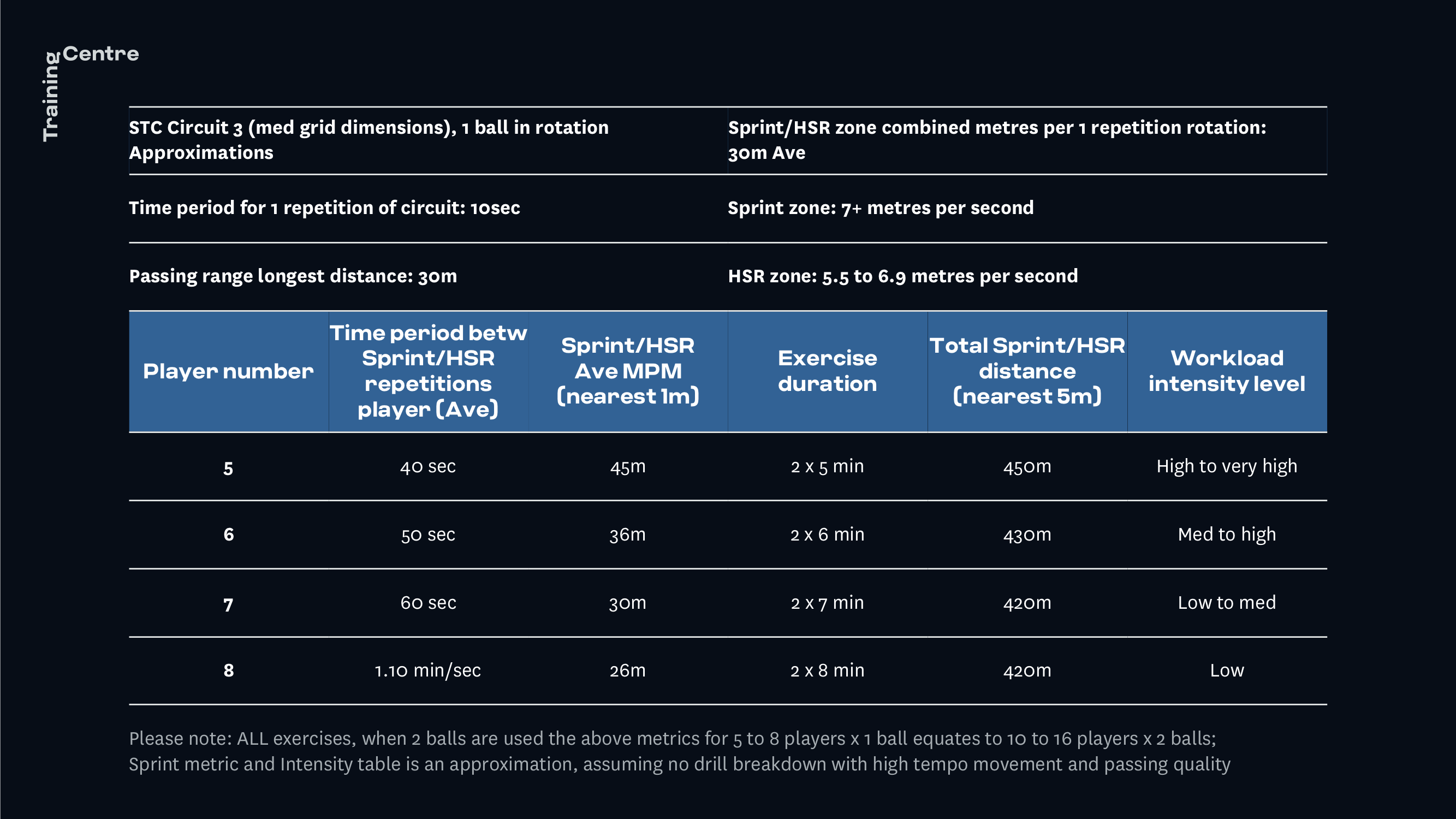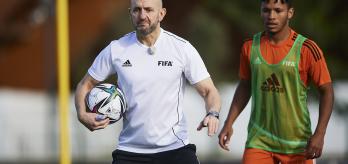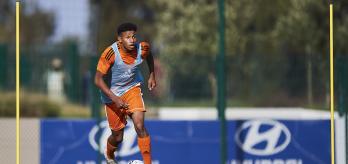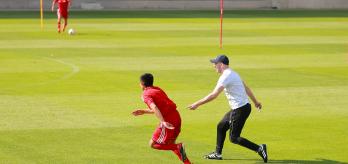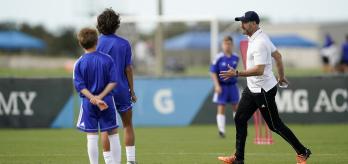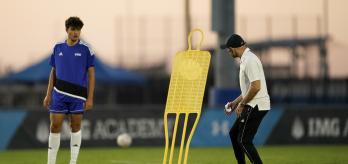A central element of this training method is the combination of tempo, technique and speed, along with technical coordination and passing quality. The circuit 3 drills provide a high volume football specific speed training stimulus featuring various attacking combinations that require unity between three to four players. All of the drills include finishing on goal, which enhances player enjoyment and emphasises the technical functionality aspect of the circuit.
The accelerations and high speed running (HSR) replicate various angles of movement encountered in match scenarios. In addition, efficiency of movement, the technical balance of two footedness and good footballing habits are all priorities within each drill.
The following movement scenarios feature in the exercises:
Long vertical combinations: turning forward to pass to a third player running in behind from a deep position to finish on goal.
Breaking through the lines: powering infield from out wide and latching on to a vertical pass at pace with the ball at feet, before playing an angled one two, collecting the return pass and finishing on goal.
Switching play from one side to finish on the other: the ball is played into the path of a player who makes an infield run from a deep position and plays an angled vertical pass to a player positioned on a higher line on the opposite side of the pitch, who makes a run in behind before finishing on goal.
Third player runs on to the ball before playing the fourth player in behind: a long cross field pass is played to a third player, who runs from a deep position, before playing a cross field ball into the path of the fourth player, who is positioned on the opposite side of the pitch and runs infield before finishing on goal.
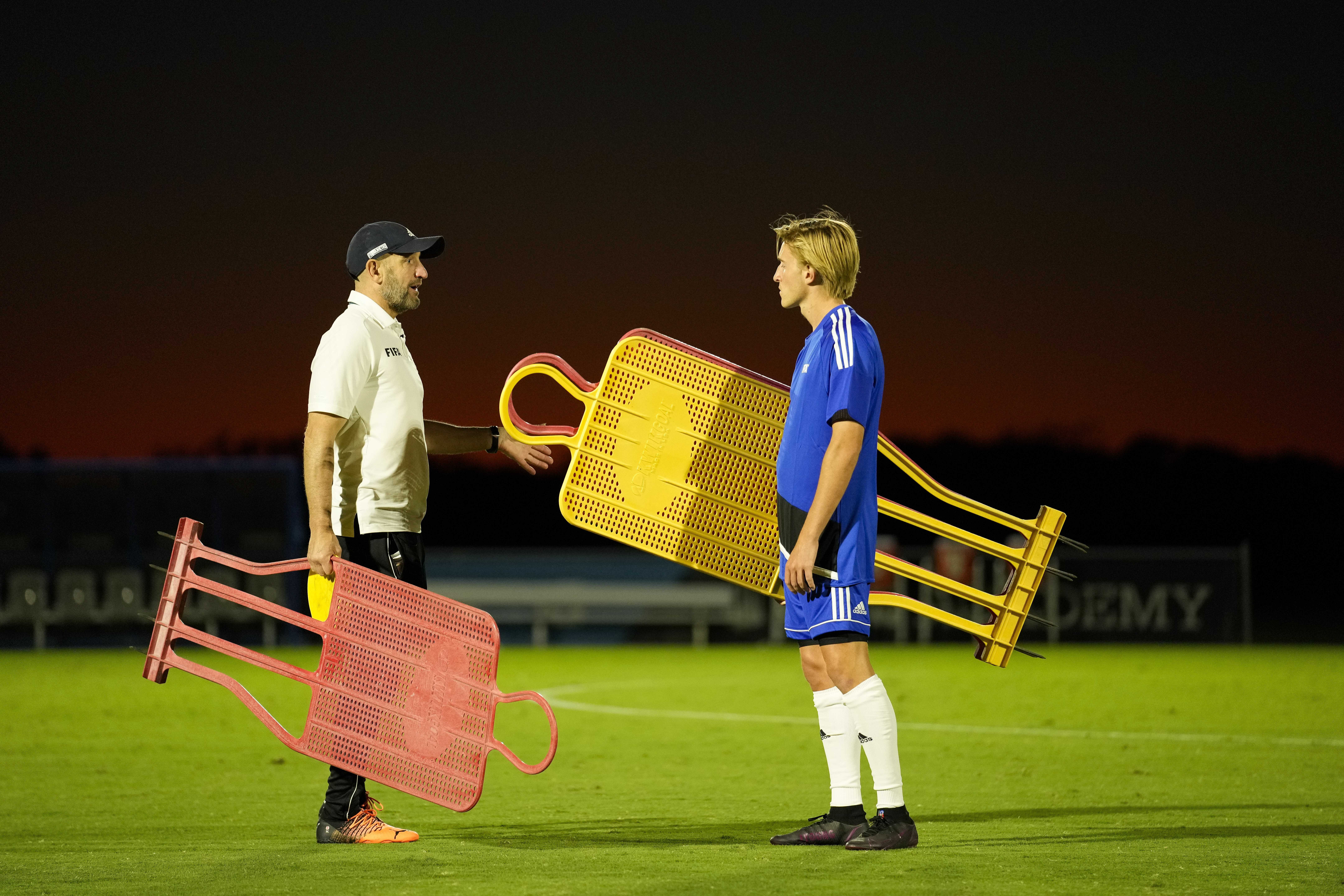
Circuit 3 features four grid sizes (very small, small, medium and large) that correspond to the sprint and HSR distances, as well as the passing ranges involved in the drills. The size of the grid should be adapted to the age group.
Drills 1 to 3 can be performed using one ball in rotation amongst a minimum of five players and a maximum of eight players, or two balls for between ten and 16 players. Drill 4 requires a minimum of seven players. The fewer the players involved, the greater the overall workload intensity. This applies to the rotations involving both one and two balls. For the purposes of this article, we have selected the medium size grid to demonstrate the drills, which feature distances of between 15 and 45 metres in the sprint/HSR zones per player per repetition.
A table featuring the speed metrics and workload intensity is provided at the end of each session plan. It offers approximate figures regarding the distance covered in the sprint/HSR zones and information on the intensity of the exercises relative to the player numbers. A table detailing the player starting positions is also provided for all drills to ensure that all players (from a total of five up to 16) take up the correct starting position.
Set-up for all drills
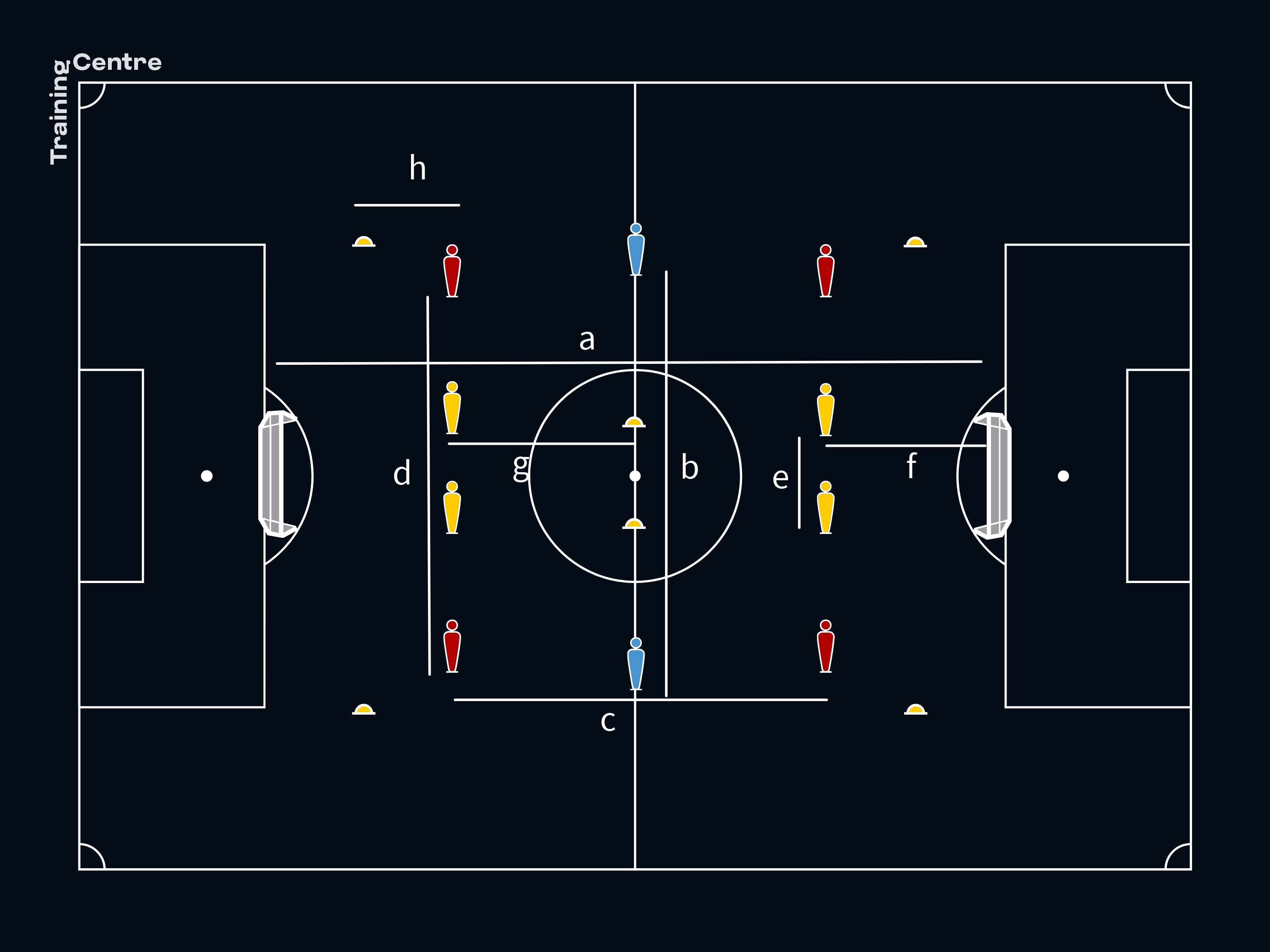
-
Lay out a 70x40m grid using 2 goals and 2 mannequins or poles (a and b).
-
Mark out a 30x34m area inside the grid using 4 mannequins or poles (c and d).
-
Create a 7 metre gate at the midpoint of both d lines (e) using mannequins or poles.
-
Place a goal at each end of the grid, 20m behind the mannequin/pole gates (f).
-
Create a 7-metre wide goal at the midpoint of the grid using 2 flat disks or cones placed 15m from the 2 central mannequin/pole gates (g).
-
Place a flat disk or cone in each corner of the grid, setting them 7.5m (h) beyond the wide mannequins/poles (d) and in line with the most outer lying mannequins/poles (b).
-
If no mannequins are available, a mixture of poles, cones or flat discs may be used instead.
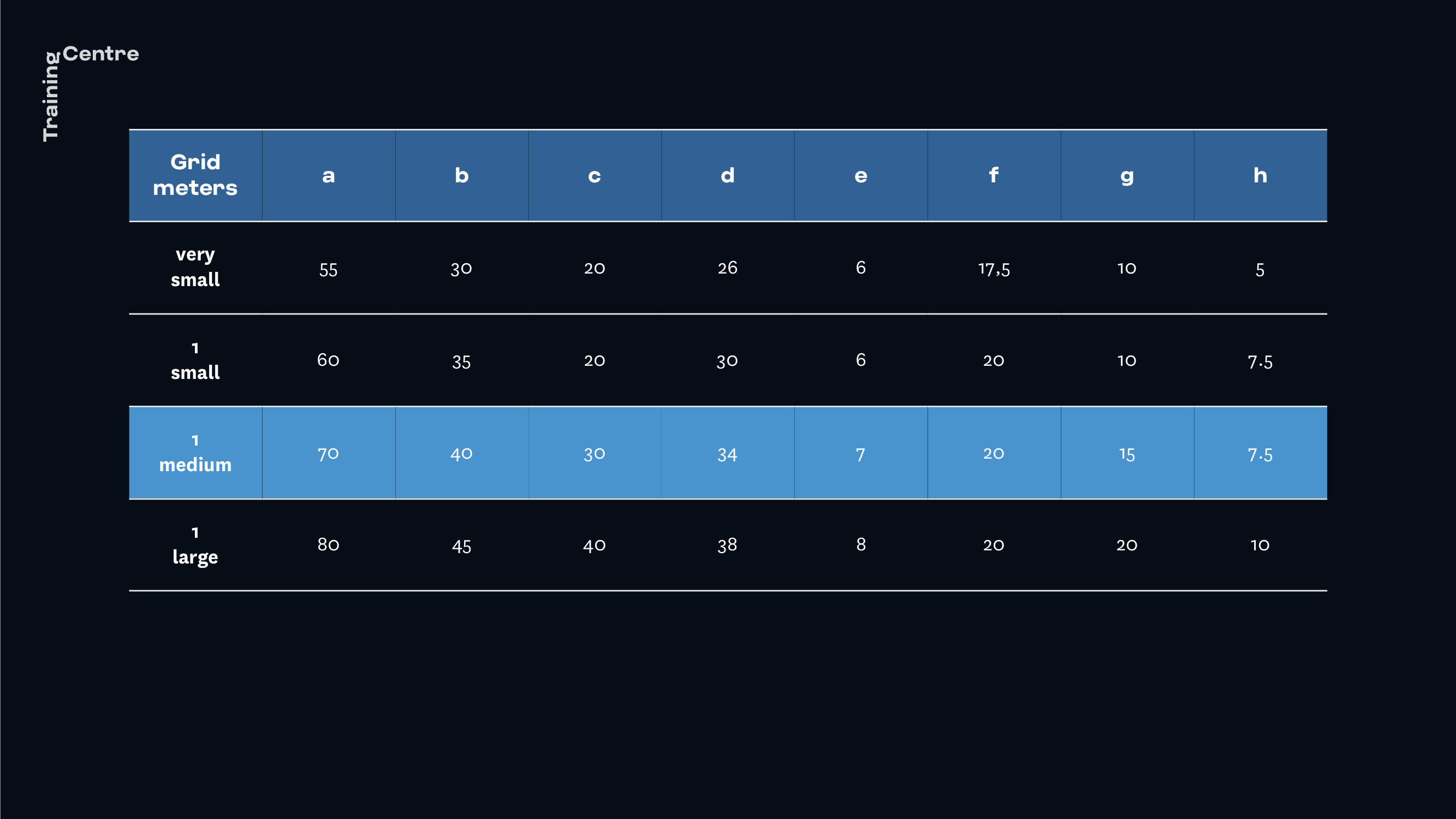
Drill duration
-
5 players (10 players with 2 balls): 2 x 5-6 minutes
-
6 players (12 players with 2 balls): 2 x 6-7 minutes
-
7 players (14 players with 2 balls): 2 x 7-8 minutes
-
8 players (16 players with 2 balls): 2 x 8-9 minutes
Approximate workload intensity (slight variations between drills)
-
5 players (10 players with 2 balls): very high to high
-
6 players (12 players with 2 balls): high to medium
-
7 players (14 players with 2 balls): medium to low
-
• 8 players (16 players with 2 balls): low
Coaching points that apply to all drills
-
Give players 1 2 minutes to find their tempo and familiarise themselves with the scenario, before gradually raising the tempo and intensity.
-
Devote a period of time (minimum of 3 4 minutes) during each drill to focus on high tempo, correct technique, technical balance (two footedness) and the reinforcement of awareness habits.
-
The drill duration relates to the ball rolling time. Stop the watch if the drill is interrupted for more than a few seconds.
-
Encourage players to move quickly between positions. This is particularly relevant when there are few players involved in the drill, e.g. 5 6 players with 1 ball or 10 12 players with 2 balls.
-
Place the emphasis on playing a quality pass into the path of the next player in the sequence.
-
Players should play with their heads up, scanning the area they are receiving the pass from and the intended destination of their pass.
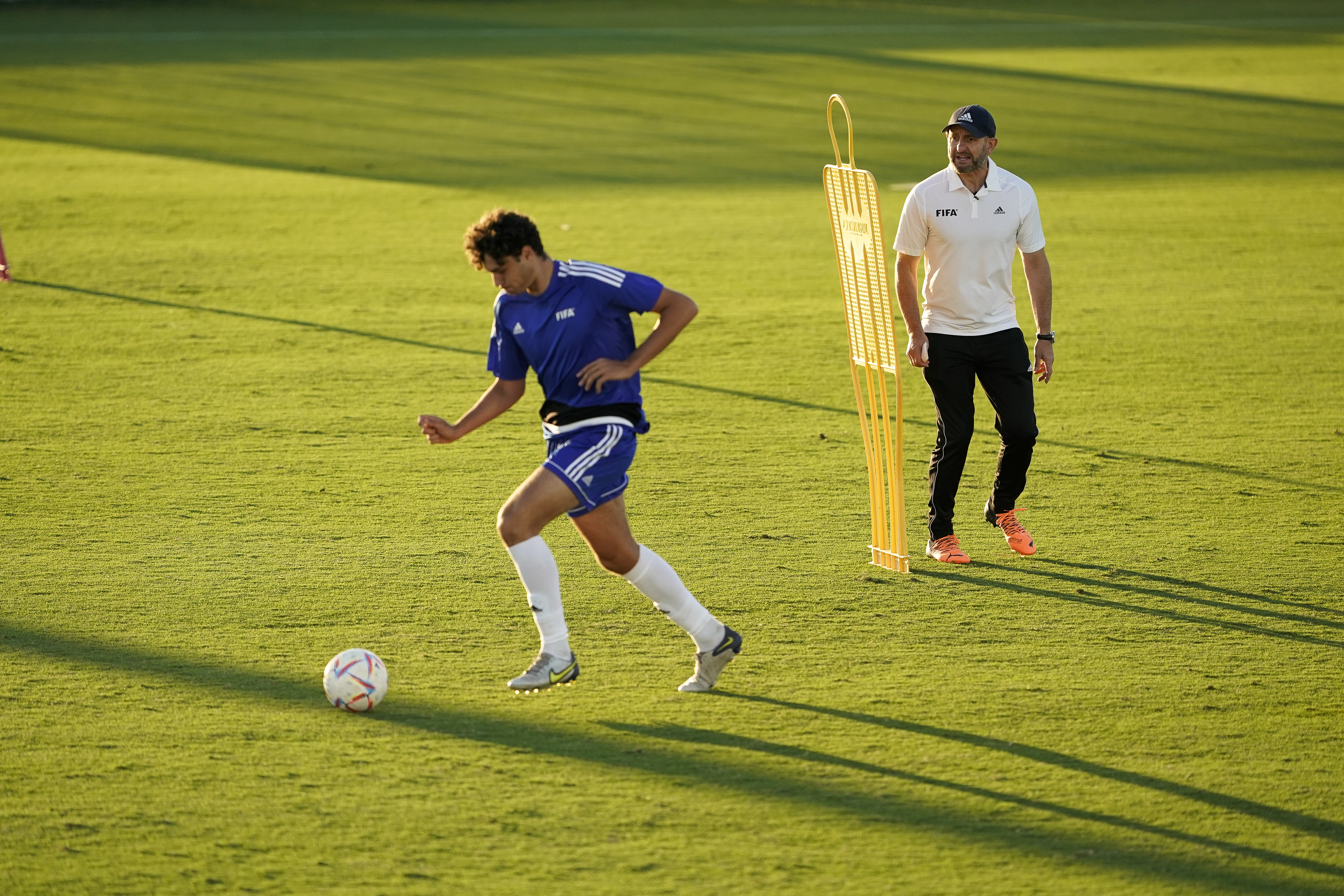
-
Encourage players to finish quickly on goal, with a limited number of touches (one or two).
-
When performing the drills with 6 players, a coach/server is required to permanently occupy one of the starting positions and play the first pass in each rotation. Where 5 players are involved, a coach/server is required at the starting positions at both ends of the grid.
-
To ensure continuous, uninterrupted ball rotation, a minimum of 20 balls is required (10 at each starting position).
-
Where a session involves a particular focus on player positioning, the drills offer the flexibility to allow players to remain in the same position, i.e. defenders and midfielders can play passes 2 and 3, with attacking midfielders and forwards making the runs that offer them exposure to the sprint/HSR zones. However, this will result in large disparities in speed metrics and intensity levels between individual players. In addition, it will also pose a challenge for the coach in terms of ensuring that the sprint/HSR workloads are well distributed amongst the players. Rotating players between positions represents the most effective means to achieving a high volume speed metric outcome for all players.
-
The complete sequence in drill 2 does not involve a full left and right movement rotation. As a result, in order to achieve complete technical balance, the second sequence should be performed in the opposite direction to the first.
Drill 1: move forward into space on the half turn to receive, before playing a vertical pass to a player making a high speed, infield run
-
A plays an angled vertical pass wide of the mannequin gate to B.
-
B quickly moves wide of the gate, shifting the ball forward into space with their first touch, before playing a long angled pass into C’s acceleration path.
-
C, who takes up a starting position at the wide mannequin, makes a long, infield run at high speed in time with the movement and passing interaction involving A and B, before latching on to the ball and finishing quickly on goal.
-
The sequence continues from the opposite end of the grid.
-
When the rotation features 2 balls, the sequence begins with a pass played simultaneously from A and A’.
-
Every player follows their pass to ensure player rotation.
-
A becomes B.
-
B becomes C.
-
C becomes A’.
-
When 5 or 6 players are involved in the drill, coaches/servers are required to permanently occupy the A/A’ starting positions. Where the coaches/servers occupy both starting positions, the players rotate between positions B and C.
-
Place the emphasis on playing a quality pass into the path of the next player in the sequence.
-
This drill promotes technical balance, requiring the use of the left and right foot in equal measure.
-
To reinforce good footballing habits, B should be encouraged to scan across to C before receiving the ball from A.
-
B should receive the ball half turned forward, while simultaneously lifting their head up, before playing the long vertical pass to C.
-
B and B’ should be encouraged to use both their left and right foot to play the long vertical pass. Encourage players to use the most appropriate foot to increase the efficiency of the sequence.
-
To reinforce good footballing habits, C should scan across to B to time their high speed run to meet B’s pass.
-
C: each individual acceleration should cover a distance of approximately 30m in the sprint/HSR zones.
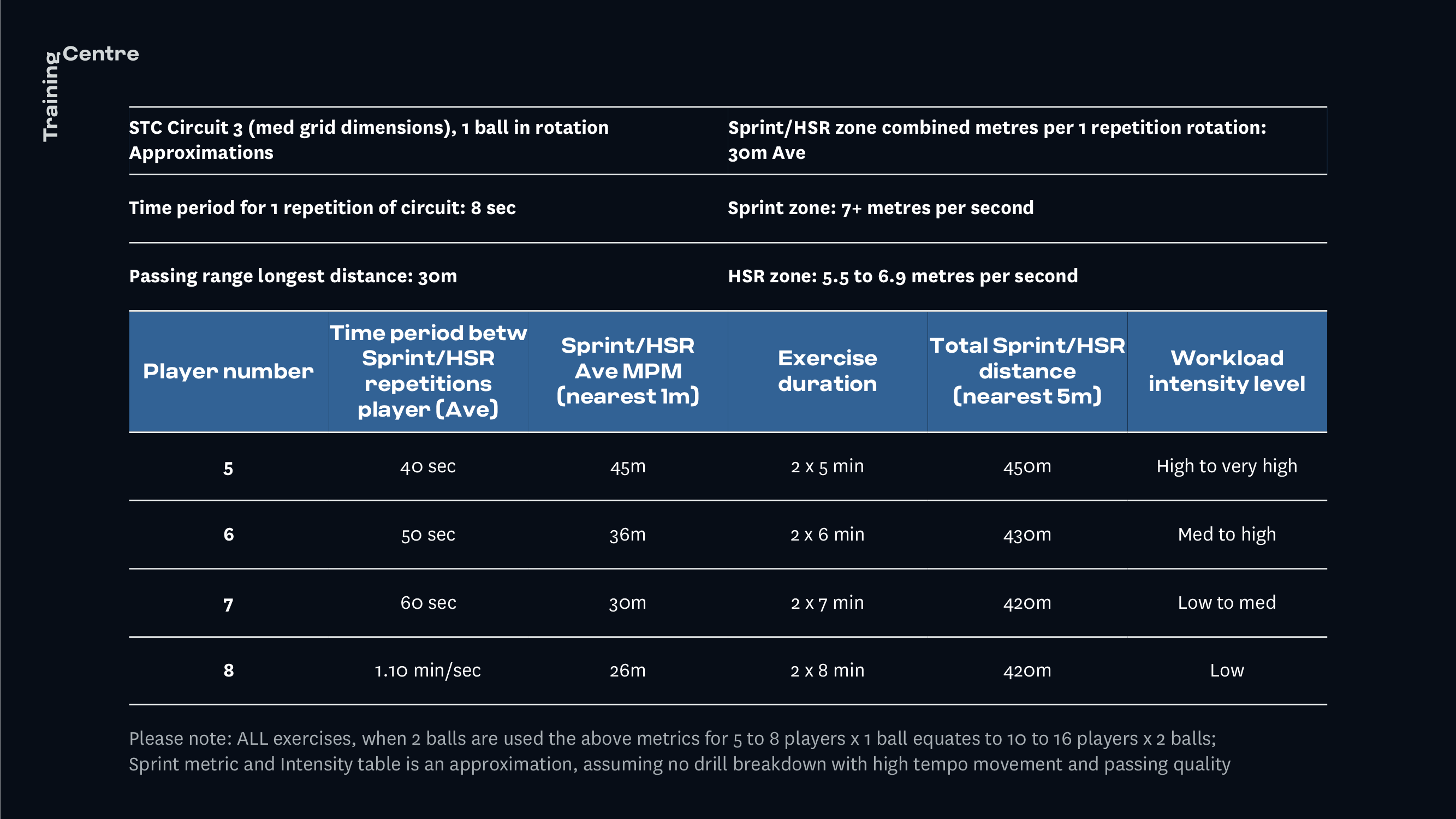
Drill 2: vertical pass played to a player running infield from a deep position out wide, who plays a one-two before finishing on goal
-
A plays an angled vertical pass wide of the mannequin gate to B.
-
B moves wide of the gate, shifting the ball beyond it, before slotting an angled pass into the forward space and C’s acceleration path.
-
C, who takes up a starting position at the wide mannequin, darts infield with a high speed run that is in time with B’s movement and passing interaction.
-
C then drives forward with the ball and plays a short, angled one two with player B at the opposite end, before connecting with the return ball and finishing on goal.
-
NB: B completes two actions during the rotation: firstly, the lay off to C and then the vertical pass to the next player C in the sequence.
-
The sequence continues from the opposite end of the grid.
-
When the rotation features 2 balls, the sequence begins with a pass played simultaneously from A and A’.
-
Every player follows their pass to ensure player rotation.
-
A becomes B.
-
B becomes C.
-
C becomes A’.
-
When 5 or 6 players are involved in the drill, coaches/servers are required to occupy the A/A’ starting positions. Where the coaches/servers occupy both starting positions, the players rotate between positions B and C.
-
Place the emphasis on playing a quality pass into the path of the next player in the sequence.
-
This drill promotes technical balance, requiring the use of the left and right foot in equal measure.
-
To reinforce good footballing habits, B should be encouraged to scan across to C before receiving the ball from A.
-
B should step forward to meet the ball on the front foot, while simultaneously shifting it into the space wide of the mannequin and getting their head up, before playing the vertical pass to C.
-
When playing the vertical pass to meet C’s angled left to right high-speed run, B should be encouraged to play a left footed pass. The opposite applies for the right to left high speed run, where B should be encouraged to play a right footed pass to C.
-
To reinforce good footballing habits, C should scan across to B to time their sprint/high speed run to meet B’s pass.
-
C should be encouraged to finish first time.
-
C: each individual acceleration should cover a distance of approximately 20m in the sprint/HSR zones.
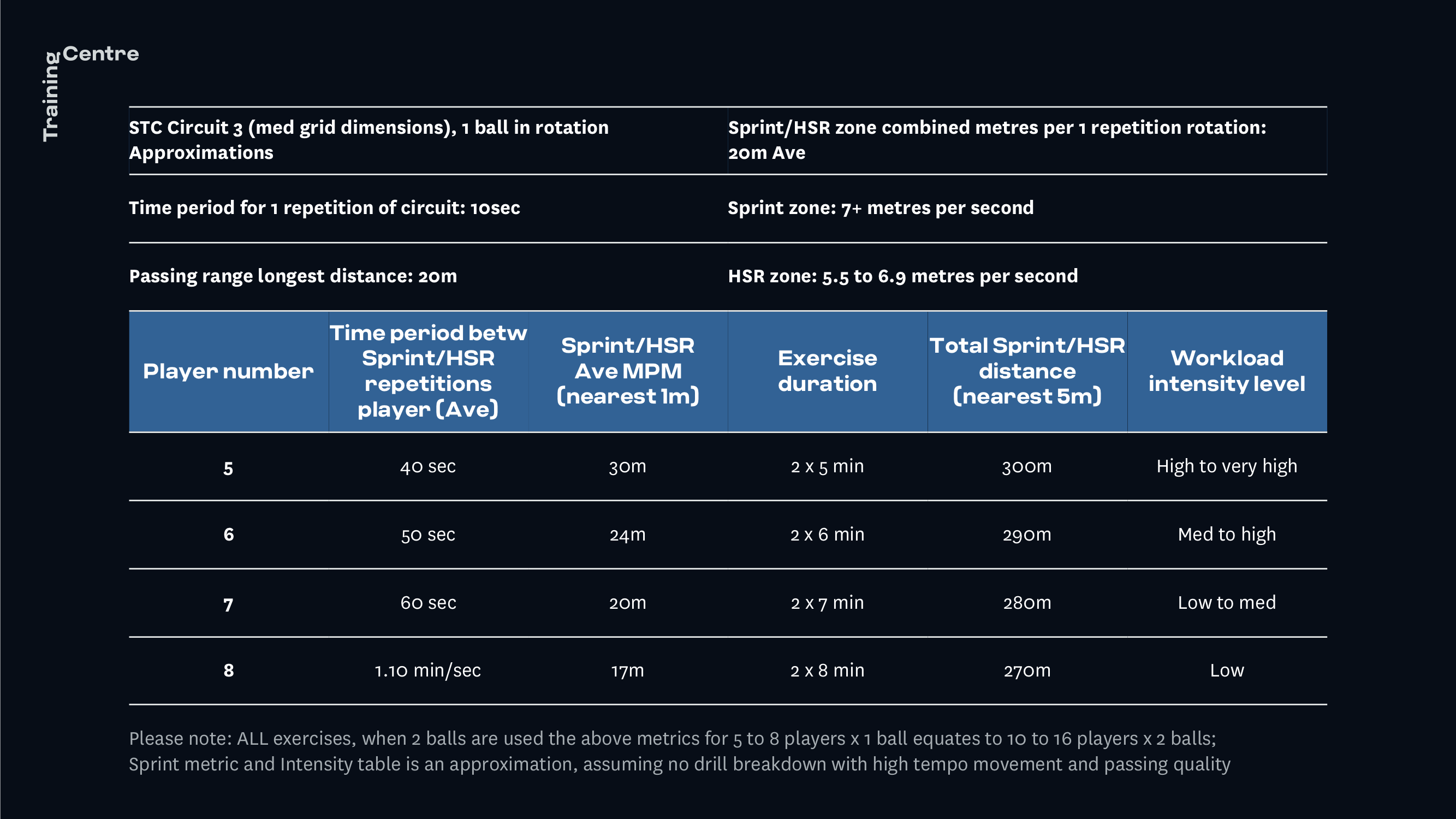
Drill 3: four player combination with 2 runners from opposite sides of the grid combining
-
A plays an angled vertical pass wide of the mannequin gate to B.
-
B moves quickly wide of the gate to receive the ball, shifting it forward with their first touch to play a long diagonal pass angled into C’s acceleration path.
-
C makes a long sprint/high speed run from out wide behind B’s line, in time with the passing interaction between A and B, before latching on to B’s pass and powering beyond the line of mannequins to play an cross field ball in for D.
-
D accelerates infield from the wide mannequin on the opposite side of the grid to connect with the ball and finish on goal.
-
The sequence continues from the opposite end of the grid.
-
When the rotation features 2 balls, the sequence begins with a pass played simultaneously from A and A’.1
-
Every player follows their pass to ensure player rotation.
-
A becomes B.
-
B becomes C.
-
C becomes D.
-
D becomes A’.
-
Drill 3 requires a minimum of 7 players. When 7 or 8 players are involved in the drill, coaches/servers are required to occupy one or both of the A/A’ starting positions. Where the coaches/servers occupy both starting positions, the players rotate between positions B, C and D.
-
Place the emphasis on playing a quality pass into the path of the next player in the sequence.
-
This drill promotes technical balance, requiring the use of the left and right foot in equal measure.
-
To reinforce good footballing habits, B should be encouraged to scan across to C before receiving the ball from A.
-
B should receive the ball half turned forward, while simultaneously lifting their head up, before playing the long diagonal pass in to C.
-
To promote technical balance, B and B’ should be encouraged to use both their left and right foot to play the long diagonal pass. Encourage players to use the most appropriate foot to increase the efficiency of the sequence.
-
To reinforce good footballing habits, C should scan towards B to time their sprint/high speed run to meet B’s pass.
-
To promote technical balance, when playing the left to right cross field pass, C should be encouraged to play a left footed pass. The opposite applies for the right to left cross field pass to D, where C should be encouraged to play a right footed pass.
-
To reinforce good footballing habits, D should scan across to C to time their infield acceleration with C’s movement and touch, with the aim of arriving late to meet C’s pass.
-
To promote technical balance, D should be encouraged to use both the left and right foot to finish on goal.
-
C and D: should cover a combined distance of approximately 45m in the sprint/HSR zones.
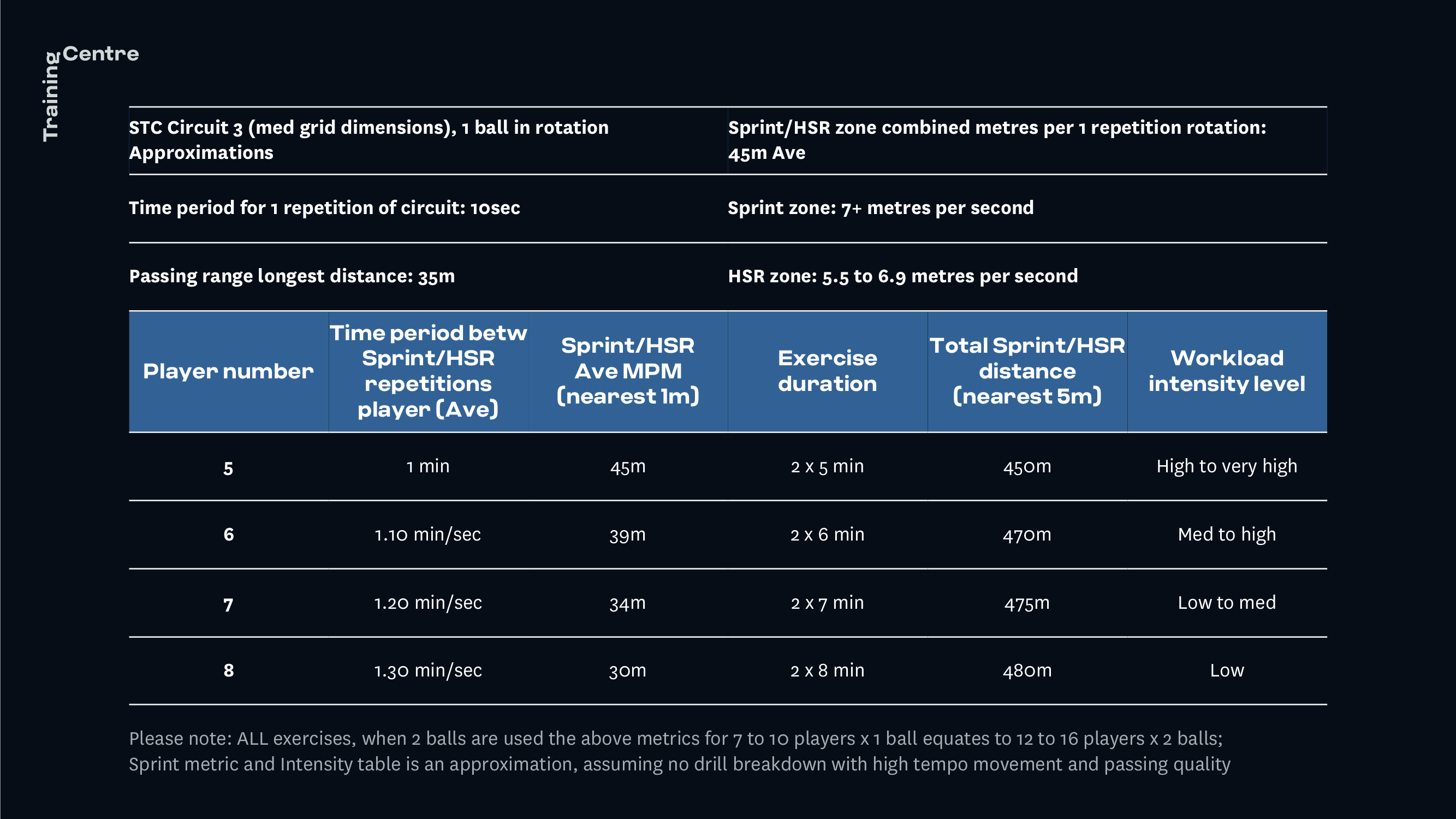
Drill 4: angled vertical pass to the runner making the run infield beyond the line, followed by an across field diagonal pass played in behind for the wide runner coming inside to finish on goal
-
A plays a vertical pass angled towards B’s infield acceleration path.
-
B makes a run from out wide behind the line of mannequins and latches on to the pass and with the ball at their feet, drives further infield to play a sweeping diagonal cross field pass to meet C’s in behind acceleration.
-
C accelerates infield from out wide to behind the mannequin line to connect with the ball and finish on goal.
-
The sequence continues from the opposite end of the grid.
-
When the rotation features 2 balls, the sequence begins with a pass played simultaneously from A and A’.
-
Every player follows their pass to ensure player rotation.
-
A becomes B.
-
B becomes C.
-
C becomes A’.
-
When 5 or 6 players are involved in the drill, coaches/servers are required to occupy the A/A’ starting positions. Where the coaches/servers occupy both starting positions, the players rotate between positions B and C.
-
Place the emphasis on playing a quality pass into the path of the next player in the sequence.
-
This drill promotes technical balance, requiring the use of the left and right foot in equal measure.
-
To reinforce good footballing habits, B should scan across towards A to time their acceleration with A’s pass.
-
To promote technical balance, when playing the left to right cross field pass to C, B should be encouraged to play a right footed pass. The opposite applies when playing the right to left cross field, with B encouraged to play a left footed pass. Encourage players to use the most appropriate foot to increase the efficiency of the sequence.
-
To reinforce good footballing habits, C should scan across to B to time their high speed run in with B’s movement and pass.
-
To promote technical balance, C should be encouraged to use both the left and right foot to finish on goal.
-
B and C: should cover a combined distance of approximately 30m in the sprint/HSR zones.
